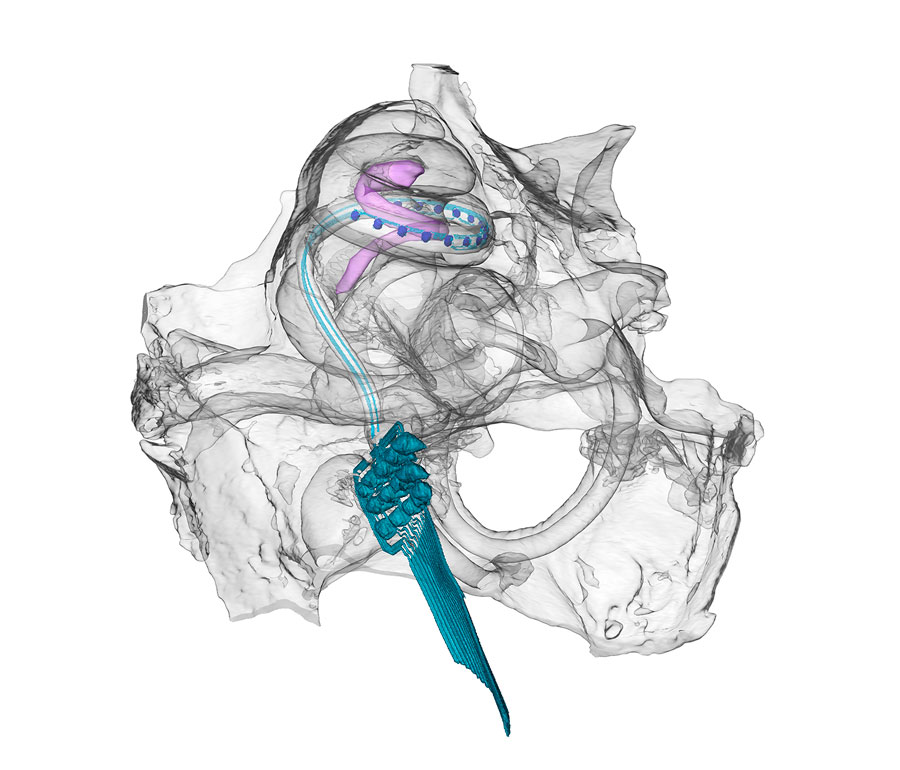Lighting array in the ear: First use of multi-channel cochlear implants with microscale light-emitting diodes
A milestone in hearing research: Researchers at the University Medical Center Göttingen and the University of Freiburg combine for the first time gene therapy in the cochlea with optical cochlear implants to optogenetically activate the auditory pathway in gerbils. Published in EMBO Molecular Medicine.

Optical cochlear implant in the cochlea of a gerbil. © Prof. Salditt, Uni Göttingen
UMG/MBExC/ Conventional hearing prostheses, so-called cochlear implants (CI), stimulate the auditory nerve of severely hearing impaired or deaf people by applying electric currents. However, the quality of this artificial hearing is far from the quality of natural hearing. This is particularly evident in a poor speech understanding in environments with background noise. Further, the perception of music is clearly restricted. In the future, a fundamental improvement in hearing could be achieved with a cochlear implant if it was possible to activate the auditory nerve spectrally selective. Since light – in comparison to electric currents – can be better spatially confined, this would enable a highly precise activation of the auditory nerve.
Hearing researchers from Göttingen led by Prof. Dr. Tobias Moser and a team of engineers from the Department of Microsystems Engineering (IMTEK) at the University of Freiburg led by Dr. Patrick Ruther have now taken a big step towards the development of an optical cochlear implant. Since the auditory nerve does not naturally react to light, it must first be made light-sensitive through gene therapy. An animal model for human hearing loss with a genetically modified, light-sensitive auditory nerve, developed at the Institute of Auditory Neurosciences and the Cluster of Excellence Multiscale Bioimaging: From Molecular Machines to Networks of Excitable Cells (MBExC) at the University Medical Center Göttingen (UMG), has now been used to test a new cochlear implant for hearing with light. The results show: Optical CIs based on microscale light-emitting diodes (μLED) enable the activation of the genetically modified auditory nerve with a high spectral precision. The research results were published in the renowned journal “EMBO Molecular Medicine” on June 29, 2020.
Original publication: µLED-based optical cochlear implants for spectrally selective activation of the auditory nerve. Alexander Dieter, Eric Klein, Daniel Keppeler, Lukasz Jablonski, Tamas Harczos, Gerhard Hoch, Vladan Rankovic, Oliver Paul, Marcus Jeschke, Patrick Ruther, Tobias Moser, EMBO Molecular Medicine, 29.06.2020, doi: 10.15252/emmm.202012387; * equal distribution
“This is an important milestone in the development of future clinical optical cochlear implants. We have taken a big step towards the clinical application of future optical cochlear implants,” says the senior author of the publication Prof. Dr. Tobias Moser, Director of the Institute of Auditory Neurosciences, UMG, and spokesperson of the Cluster of Excellence Multiscale Bioimaging (MBExC).
>> original press release (German)
Original publication
µLED-based optical cochlear implants for spectrally selective activation of the auditory nerve. Alexander Dieter, Eric Klein, Daniel Keppeler, Lukasz Jablonski, Tamas Harczos, Gerhard Hoch, Vladan Rankovic, Oliver Paul, Marcus Jeschke, Patrick Ruther, Tobias Moser, EMBO Molecular Medicine, 29.06.2020, doi: 10.15252/emmm.202012387; * equal distribution




